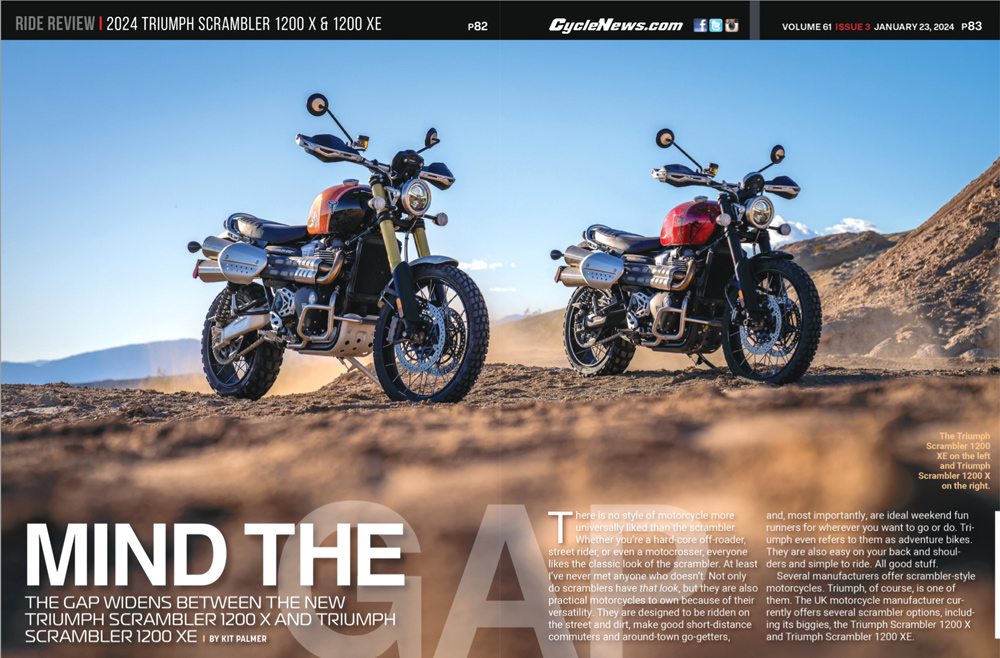Kit Palmer | January 26, 2024
There is no style of motorcycle more universally liked than the scrambler. Whether you’re a hard-core off-roader, street rider, or even a motocrosser, everyone likes the classic look of the scrambler. At least I’ve never met anyone who doesn’t.
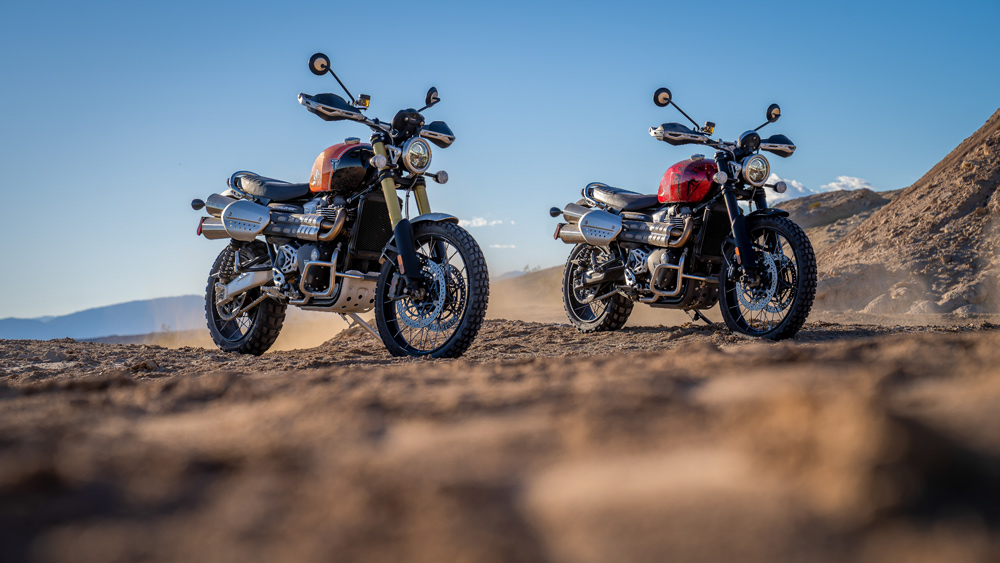 The Triumph Scrambler 1200 XE on the left and Triumph Scrambler 1200 X on the right.
The Triumph Scrambler 1200 XE on the left and Triumph Scrambler 1200 X on the right.
Not only do scramblers have that look, but they are also practical motorcycles to own because of their versatility. They are designed to be ridden on the street and dirt, make good short-distance commuters and around-town go-getters, and, most importantly, are ideal weekend fun runners for wherever you want to go or do. Triumph even refers to them as adventure bikes. They are also easy on your back and shoulders and simple to ride. All good stuff.
Several manufacturers offer scrambler-style motorcycles. Triumph, of course, is one of them. The UK motorcycle manufacturer currently offers several scrambler options, including its biggies, the Triumph Scrambler 1200 X and Triumph Scrambler 1200 XE.
Before the 1200 X, from 2019 to 2023, there was the Scrambler 1200 XC. The former XC is now replaced by the X. The Scrambler 1200 X is essentially a Scrambler 1200 XC but with enough significant changes that Triumph chose to ditch the “C.” The latest XE also sees some changes, but fewer than the X. So, why the change from XC to X?
The previous XC and XE were similar models; a little too similar, as it turns out. The XC was aimed a little more at pavement riding than the XE, but the difference between the XC and XE was negligible. Sure, the XC’s seat height was lower than the XE’s, but not low enough to really matter. The XC’s handlebars were narrower, but not by much. Wheel travel was similar, too, and they shared the same size front and rear disc brakes. Their liquid-cooled, eight-valve, SOHC, parallel-twin engines were also the same. You get the picture. They were essentially the same motorcycle.
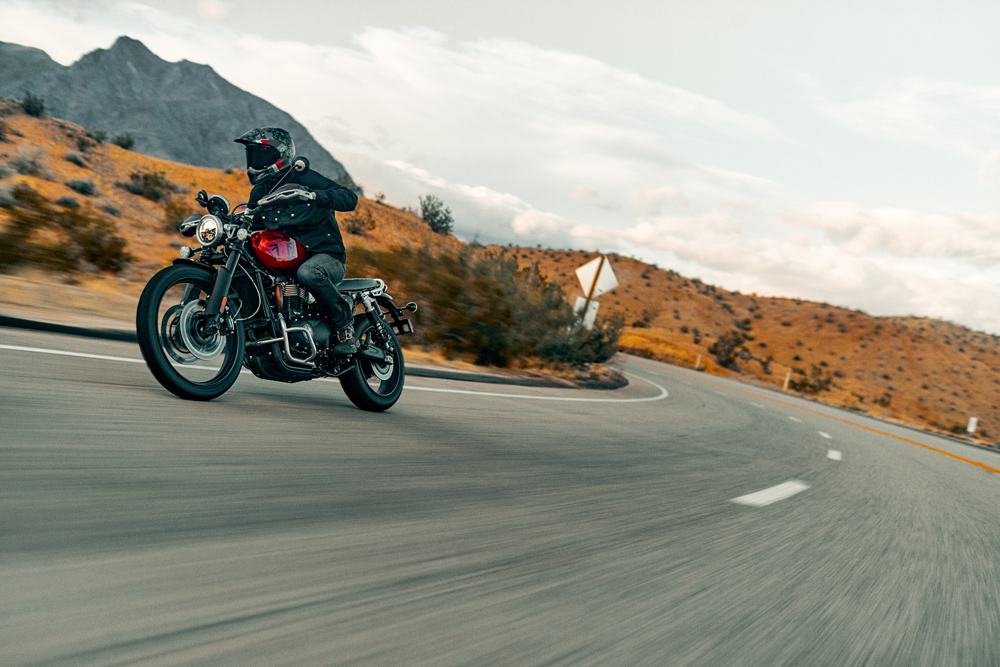 Of the two Triumph Scrambler 1200s, the X model is more road-biased. It sits closer to the ground and loves the twisties.
Of the two Triumph Scrambler 1200s, the X model is more road-biased. It sits closer to the ground and loves the twisties.
Triumph wanted to change that, so it focused on giving the X even better road mannerisms than before and widening the difference gap between it and the dirt-tuned Scrambler 1200 XE.
“The Scrambler 1200 X is a new choice for our customers,” says Triumph, “optimized to deliver the specification riders have asked for, with an even lower seat height, competitive pricing, and a better road ride than the previous Scrambler 1200 XC.”
The new XE, Triumph says, is still “built for both on-road and off-road adventures.”
The 2024 XE has a short list of changes. Mainly updated brakes, modified 45mm USD Marzocchi forks, revised intake and exhaust headers (for more torque through the upper rev range, says Triumph), and new LED indicators and headlight.
The X, however, got significantly more attention. It also has an updated Marzocchi suspension system but tuned with more emphasis on street riding. Like the previous and current XE model, the X gets advanced rider technology that was not fitted to the previous Scrambler XC, such as new optimized cornering ABS and switchable optimized cornering traction control. The X has five riding modes (Sport, Road, Rain, Off-Road and Rider Configurable), all-LED lighting, and USB charging.
However, the most important things that set apart the new X from the XE are seat height and suspension. At 32.3 inches, the X’s seat height is two inches lower than the XE’s, which is significant and an inch more (lower) than the previous XC model.
With the lower seat height comes less wheel travel. The X has three inches less front- and rear-wheel travel than the more off-road-capable XE. Again, a notable difference. Previously, there was just a one-inch difference. The X also has less ground clearance.
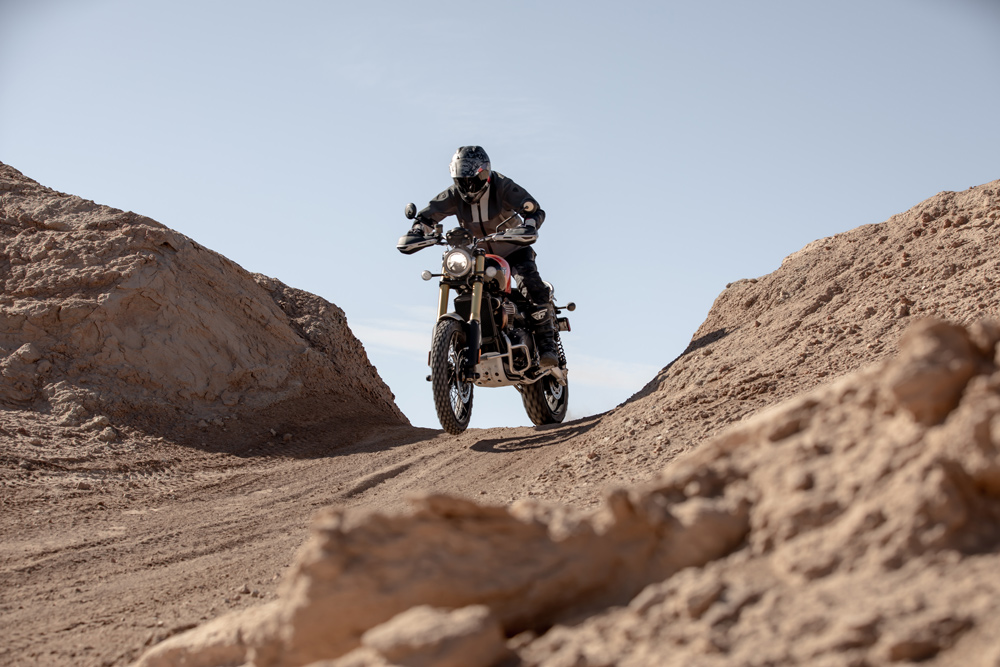 The XE doesn’t mind getting dirty.
The XE doesn’t mind getting dirty.
The XE’s suspension is fully adjustable, while the X’s is not; you only get preload in the rear with the X model. The XE’s swingarm is also longer than the X’s, which means the XE’s wheelbase is stretched out more than the X’s by 1.8 inches. The XE’s handlebars are also 2.8 inches wider than the X’s, but that’s only about a quarter of an inch more than the previous XC.
So, overall, you can see by the numbers that the new Scrambler 1200 X and the Scrambler 1200 XE are noticeably different in dimensions now.
Several other minor differences exist between the Scrambler 1200 X and Scrambler 1200 XE. For one, the XE gets one extra ride mode—Off-Road Pro, where all rider aids are turned completely off. The closest the X has to this is Off-Road mode, where everything is turned off except for front ABS. How the modes are accessed is slightly different between the X and XE, too. Still, both are simple to manipulate, accomplished via their handlebar switch blocks. Their instrument clusters have different styling, too, plus the XE’s TFT display is full color and customizable, while the X’s TFT LCD display is fixed and overall much smaller.
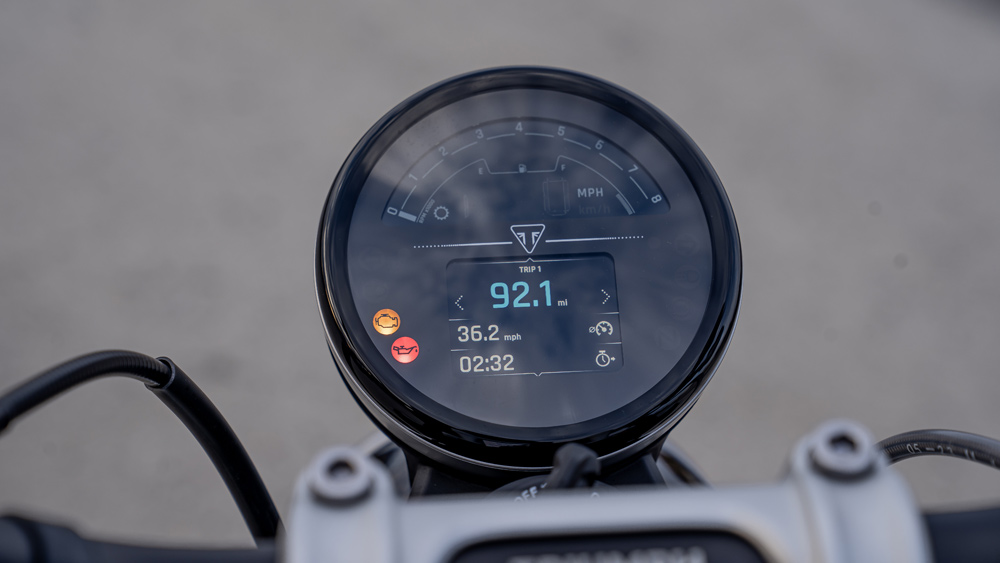 The X’s instrumentation doesn’t get much simpler than this.
The X’s instrumentation doesn’t get much simpler than this.
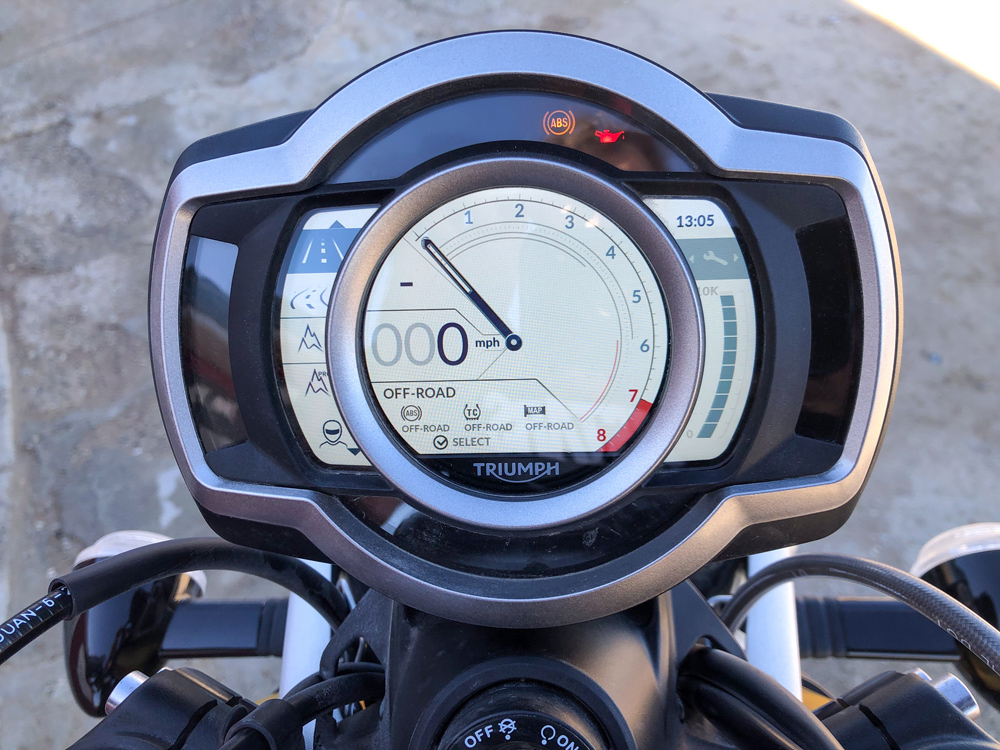 The XE’s adjustable display is nice to look at and easy to decipher.
The XE’s adjustable display is nice to look at and easy to decipher.
The XE’s bolt-on passenger footpegs are removable, while the X’s are welded to the frame. Their skid plates are also slightly different: The XE’s is beefier.
From a distance, I found the easiest way to distinguish between the two models is the XE’s gold versus the X’s black upper fork tubes, and the XE’s brushed-aluminum swingarm with matching silver front and rear fenders versus the X’s swingarm and fenders in black. They also have unique color options, but both models can be had in classic Sapphire black.
2024 Triumph Scrambler 1200 X & 1200 XE
How They Compare
Swing a leg over the X right after riding the XE, and you’ll immediately notice that the X feels much smaller in size because of its significantly lower seat height and narrower handlebars. The X’s instrument unit also looks different. It’s smaller and isn’t quite as handsome as the XE’s but, like the XE’s, is simple to decipher. So, without question, there is a noticeably different feel between the two bikes.
However, both bikes still perform similarly on the tarmac. Triumph recently invited the media to ride the X and XE, spending one day on the road and the next almost entirely on the dirt, giving us plenty of time to get to know each bike. Overall, on the road, they both handle well, but the X inspires more confidence on the twisties, at least for me, because it sits lower to the ground than the XE, feels less top-heavy, and doesn’t require as much coercion to initiate the corners. Once leaned in, the X’s front end feels a bit more planted and stable, as well, but you’ll drag the footpegs more often on the X than you will with the XE. In case you’re wondering, they roll on 21-inch front and 17-inch rear wheels.
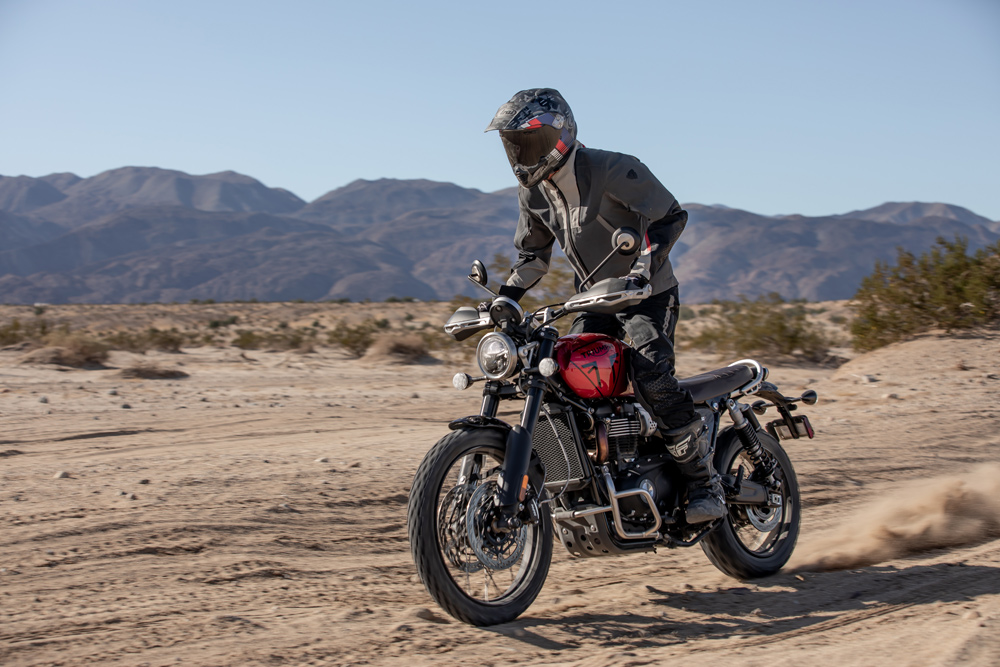 So long as you’re not in a hurry, the X is happy in the dirt.
So long as you’re not in a hurry, the X is happy in the dirt.
The X’s suspension also feels nice and plush, noticeably plusher than the XE’s. The X’s ride is pleasant at slower speeds, but when the tempo picks up or when the road gets rough, the XE’s stiffer fork and shocks stand out by doing a better job of soaking it all in. Still, the X’s non-adjustable suspension is set up from the factory well, at least for my rather light 175 pounds (with gear). Same with the XE, I did not feel the immediate need to make changes while on the pavement with either bike. I just got on them, rode, and had fun.
Although the X and XE have slightly different front brakes, both bikes slow down nicely and predictably, but the XE’s front binder has a better initial bite.
It’s when the pavement turns to dirt that the gap between the two models widens significantly, mainly due to their suspensions. The XE’s longer wheel travel and firmer tuning give it a massive advantage over the X in the dirt. I was impressed by how far you could push the XE over rough terrain and whoops before things started going awry, much further than you can the X. The X’s suspension bottoms easily and reaches its limitations quickly when ridden even remotely aggressively in the dirt because of its soft settings and short wheel travel. The only suspension adjustment you have with the X is rear preload, but that won’t really fix anything. The best remedy is to simply slow down and smell the roses when riding the X in the dirt.
The XE, on the other hand, can be ridden at a much faster pace than the X and is overall quite good off the pavement for a 500-plus-pound, twin-cylinder, 80-horsepower, twin-shock motorcycle. At first, the XE was a bit of a handful for me in the dirt, but I quickly adapted and ended up enjoying riding it off-road for the rest of the day, even in the sand. The more I rode it, the more I liked it. For this ride, Triumph fitted our bikes with Michelin Anakee Wilds knobby-style tires that were surprisingly good both on and off the road but showed signs of early wear after just two days of hard street and dirt riding. The only time I preferred being on the X than the XE on the dirt was in the sand because of its lower center of gravity and reduced seat height. This makes the X more controllable and recoverable in the soft stuff. In deep sand, the XE suddenly feels tall and heavy, but nothing that grabbing a handful of throttle wouldn’t fix. You just have to build up the nerve to do that. I’m still working on that.
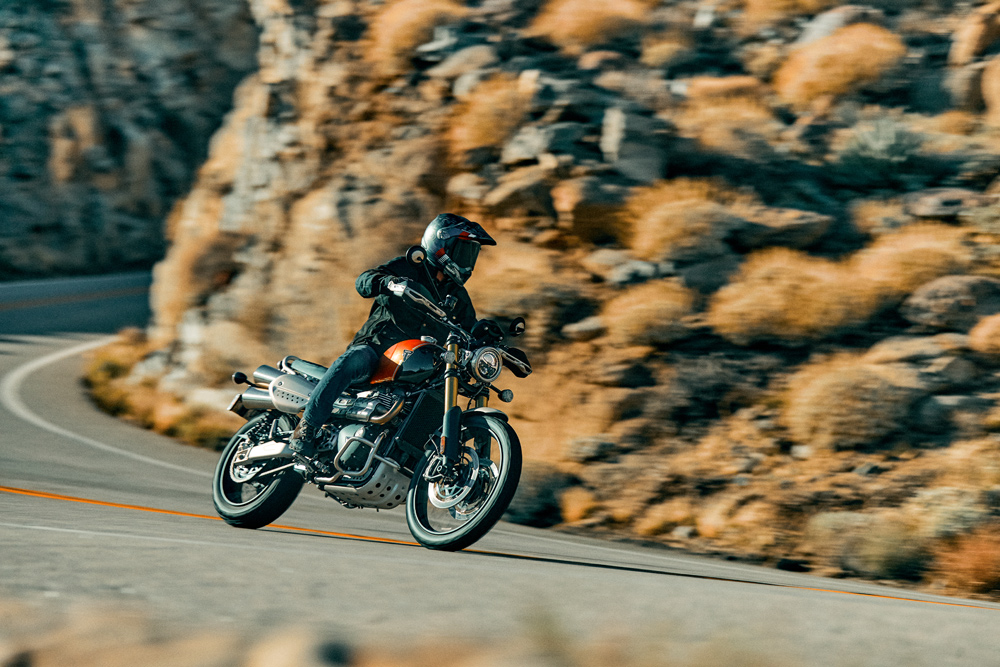 The XE is a solid and fun ride on the pavement.
The XE is a solid and fun ride on the pavement.
Any time the XE touched the dirt, I’d switch to Off-Road Pro mode, the X, Off-Road mode. Unfortunately, every time you turn the ignition off, they reset to Road mode. It’s irritating, but thankfully, it takes just three taps of a button on the left switch block, and you’re back where you left off. Super easy.
Both bikes are comfortable, but it wouldn’t surprise me at all if future Scrambler 1200 owners sought out an aftermarket seat down the road. The stock seat pad is fine but a tad on the thin side, which could be an issue when the foam starts to break down over time, however long that might take.
Triumph has a boatload of accessories for both models, including a low seat (by nearly an inch), a high windscreen, several luggage and bike protection options, and anti-theft options. One thing you won’t have to worry about buying is hand protection. Both bikes come fitted with high-quality handguards.
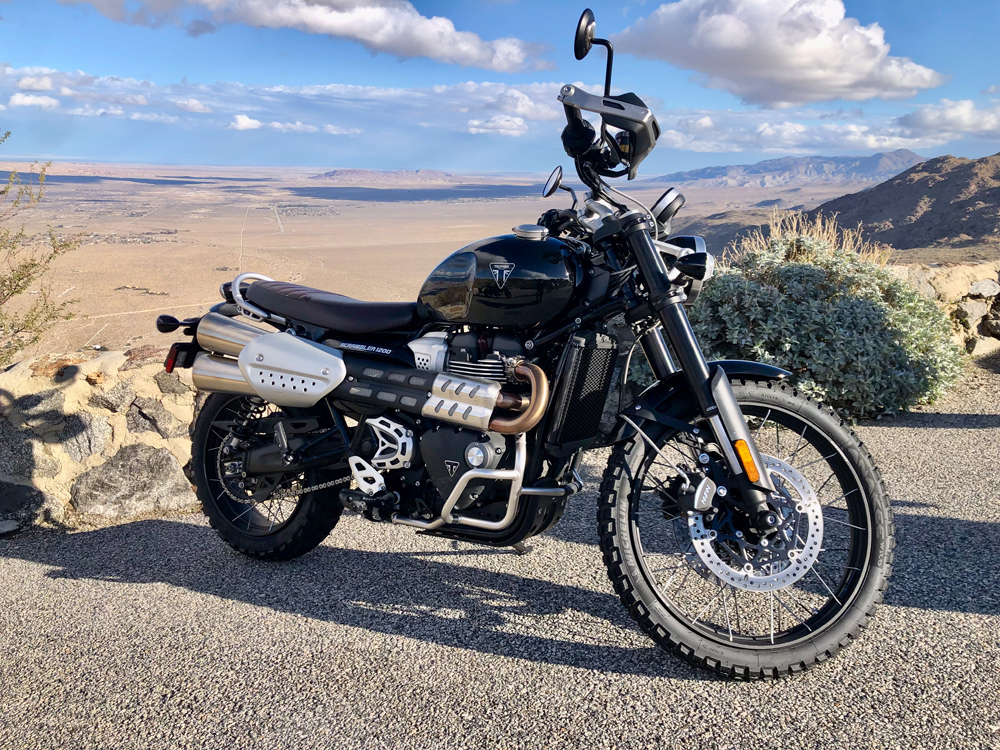 Who doesn’t like the looks of a Scrambler?
Who doesn’t like the looks of a Scrambler?
After two days of good, solid riding, both on and off the road, I realized that both bikes are exceptionally fun either way, but they have their niches. Suppose you want a Triumph Scrambler 1200 but do not intend to get it dirty. In that case, the X is the way to go, thanks to its low seat height, confidence-inspiring smaller size and softer suspension. It’s clearly a great street bike that, if the urge strikes, can handle some light-duty dirt riding on well-maintained county roads just fine. Anything more and the suspension will start to complain.
The XE, on the other hand, is not only an excellent on-road bike but also a solid off-road performer for, again, a large 1200cc twin Scrambler motorcycle with dual-shock suspension that weighs over 500 pounds and delivers approximately 80-plus horsepower, which is something I never thought I would ever say.
So, in a nutshell, if you like that look of a scrambler, more specifically the Triumph Scrambler, but off-roading isn’t your thing, and seat height is an issue, the X might be the one for you. If you crave a mix of both street and dirt—even a little rough dirt—then the XE has your name written all over it. CN
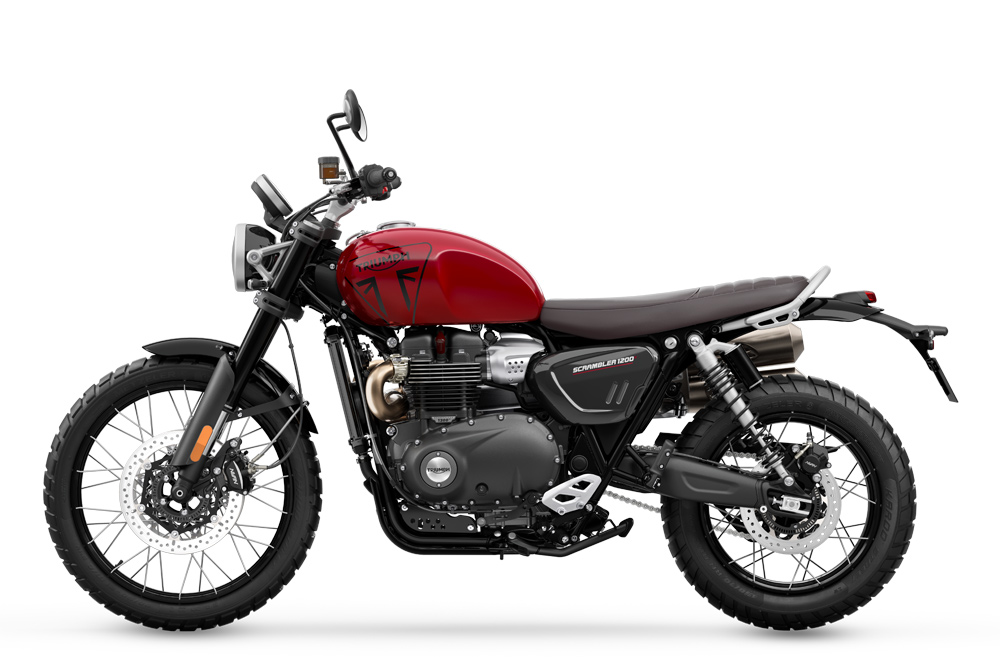
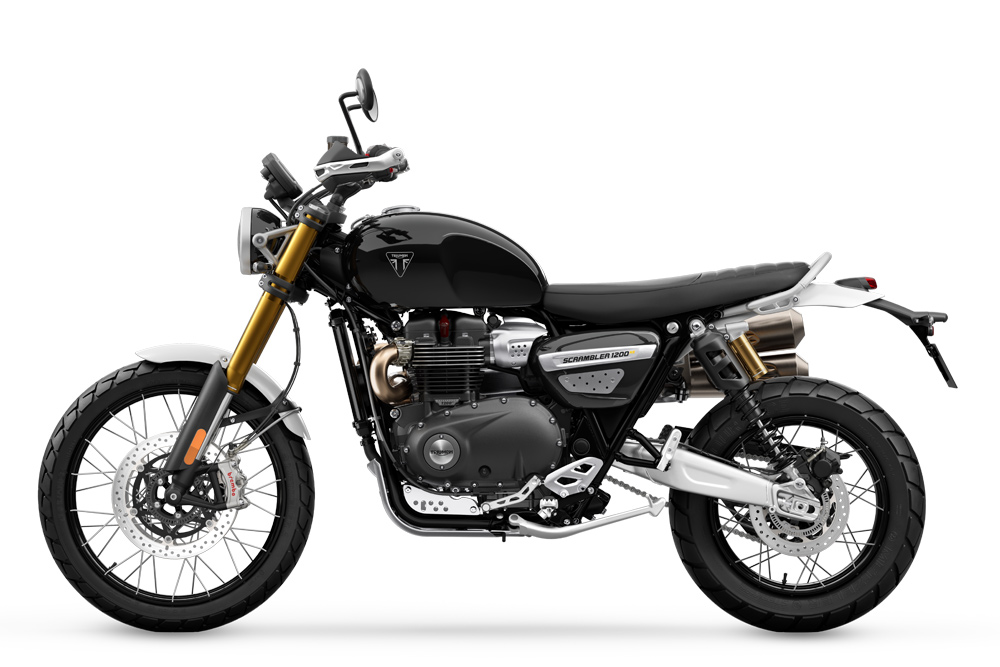
2024 Triumph Scrambler 1200 X / 1200 XE Specifications
| MSRP: |
$13,595 / $15,295 |
| Engine: |
270° parallel-twin, 4-stroke |
| Valvetrain: |
8-valve, SOHC |
| Displacement: |
1200cc |
| Cooling system: |
Liquid |
| Bore x stroke: |
97.6 x 80mm |
| Compression ratio: |
11:1 |
| Max horsepower (claimed): |
89 bhp at 7000 rpm |
| Max torque (claimed): |
81.1 ft-lbs at 4250 rpm |
| Fueling system: |
Ride-by-wire, multipoint sequential electronic fuel injection |
| Exhaust: |
2 into 2 |
| Final drive: |
X-ring chain |
| Transmission: |
6-speed |
| Frame: |
Tubular steel |
| Front wheel: |
Tubeless 36-spoke 21 x 2.15 in., aluminum rim |
| Rear wheel: |
Tubeless 32-spoke 17 x 4.25 in., aluminum rim |
| Swingarm: |
Twin-sided, aluminum fabrication |
| Front tire: |
90/90×21 in. |
| Rear tire: |
150/70×17 in. |
| Front suspension: |
Marzocchi non-adjustable USD forks / Marzocchi 45mm 1 1 forks, fully adjustable |
| Rear suspension: |
Marzocchi twin RSU’s with piggyback reservoir, preload adjustable / Marzocchi twin RSU’s with piggyback reservoir, fully adjustable |
| Front-wheel travel: |
6.7 in. / 9.8 in. |
| Rear-wheel travel: |
6.7 in. / 9.8 in. |
| Front brake: |
Twin 310mm discs, 2-piston Nissin axial caliper, ABS / Twin 320mm discs, Brembo 4-piston M4.30 radial caliper, ABS |
| Rear brake: |
Single 255mm disc, single piston floating Nissin caliper, ABS |
| Handlebar width: |
32.8 in. / 35.6 in. |
| Seat height: |
32.28 in. / 34.25 in. |
| Wheelbase: |
60.03 in. / 61.8 in. |
| Rake: |
26.2° / 26.9° |
| Trail: |
4.9 in. / 5.08 in. |
| Fuel capacity: |
3.96 gal. |
| Weight (claimed, wet): |
502.65 lbs. / 507 lbs. |
| Service interval: |
10,000 miles or 12 months |
